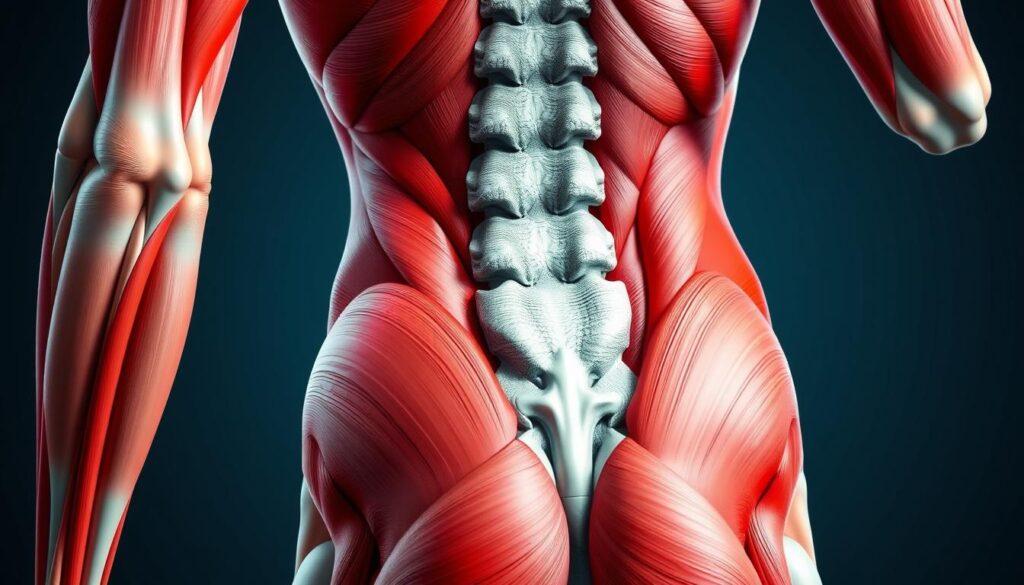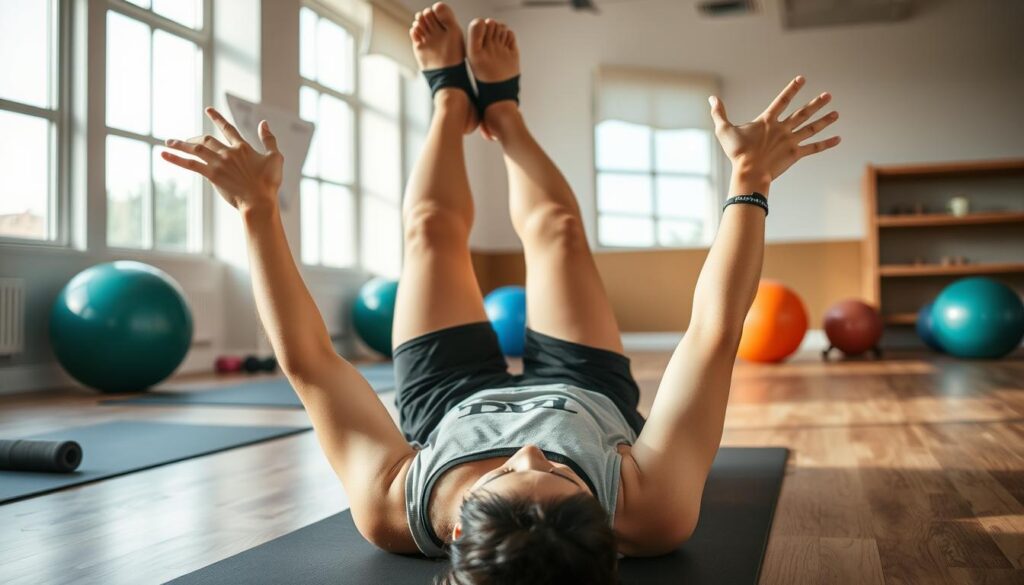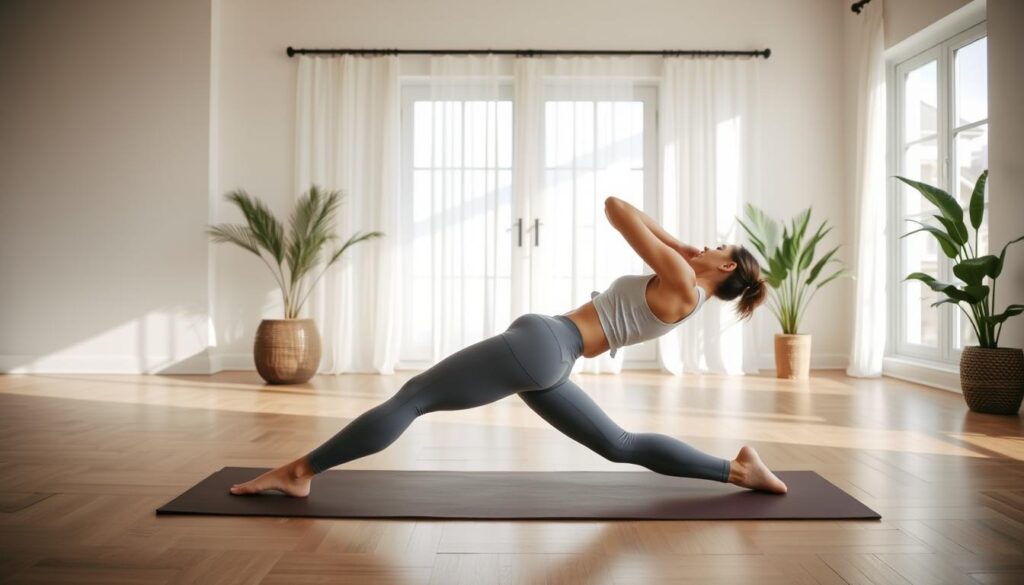Do you often deal with lower back pain or discomfort? You’re not alone. The World Health Organization WHO says more people will suffer from lower back pain LBP by 2050.
But, you can strengthen your lower back and ease pain with the right exercises and stretches.
This article will show you signs of a weak lower back and why it’s important to keep it strong. We’ll also share seven effective exercises to try.
Key Takeaways
- Weak lower back muscles can lead to discomfort, pain, and even serious injuries.
- Incorporating targeted exercises and stretches can help strengthen your lower back and support your overall core.
- Exercises like the Child’s Pose, Glute Bridge, and Plank can help alleviate and prevent lower back pain.
- Strengthening the lower back muscles is crucial for overall spine health and stability.
- Persistent or severe back pain should be checked by a healthcare professional.
What Are the Signs of a Weak Lower Back?
Joslyn Thompson Rule a Peloton instructor, says common signs of a weak lower back include weakness discomfort stiffness or pain when moving. Physical therapist Ryan LeFever notes that weakness in the lower back might show when you can’t keep proper form during an overhead squat. This is when your trunk leans forward and your arms fall forward.
Finding the true cause of lower back weakness can be hard to do alone. A physical therapist is better at spotting any bad patterns. The National Institute of Neurological Disorders and Stroke NINDS says to avoid sudden movements that might hurt your back. They recommend low-impact exercises to strengthen your back and abdominal muscles.
The NINDS also suggests being careful and gentle when stretching. It’s important to listen to your body’s limits. Using your breath as a guide during stretching can help you avoid straining too much.
Weak muscles in the lower back area can lead to imbalances instability increased risk of injury, and chronic pain.

If lower back pain doesn’t go away, doctors might suggest X-rays or MRIs to find out why. Treatment for lower back pain could include medicine like anti-inflammatories and muscle relaxers. It might also include physical therapy, injections, or surgery if the pain lasts over a year.
The Importance of a Strong Lower Back
A strong lower back is key for spine stability, injury prevention, and better fitness. It’s a big part of the core muscles. These muscles help support the spine and handle forces during exercise.
When the core, especially the lower back, doesn’t work right it can cause pain or injury. A study in The Lancet Rheumatology found low back pain affects 619 million people. This number is expected to grow to 843 million by 2050.
It’s important to strengthen the lower back and core muscles. This helps keep muscles balanced and prevents injuries. The erector spinae, quadratus lumborum, and multifidus muscles are key. Working these muscles improves spinal stability and core strength. This leads to better injury prevention and fitness performance.
There are exercises that target the lower back muscles. These include dynamic movements like windshield wipers and static holds like forearm planks. They help improve flexibility and strength in the hips, glutes abs and lower back.
80% of adults will suffer from lower back pain at some point during their lives according to the National Institutes of Health.
Adding these exercises to your fitness routine can make your lower back stronger and more stable. This can improve your overall physical health and performance.

7 Exercises for Lower Back Muscles
Keeping your lower back strong and flexible is key for a healthy spine and injury prevention. Experts suggest doing a mix of exercises that work the lower back, core, and nearby muscles. Here are 7 great exercises to strengthen your lower back:
- Dead Bug: This exercise helps control front-to-back pelvic tilting and improves core strength. Do 1 to 3 sets of 3 to 5 reps to ease lower back pain by making your abdominal muscles stronger.
- Toe Taps: This exercise engages the core and stabilizes the spine.
- Glute Bridges: Glute bridges strengthen the lower back and nearby muscles like the hamstrings and glutes. Do 15 reps, rest for 1 minute, and repeat 3 sets to make your glutes stronger and support your lower back.
- World’s Greatest Stretch: This dynamic stretch targets the hips, hamstrings, and lower back muscles.
- Hamstring Stretch with Core Engagement: This stretch not only targets the hamstrings but also engages the core for added stability.
- Side Plank: The side plank exercise strengthens the core and stabilizes the spine.
- Superman: This exercise involves repeating the set of movements for 10 times to strengthen the extensor muscles along the spine, enhancing spinal and pelvic support.
Adding these lower back exercises to your workout can boost stability, lower injury risk, and ease lower back pain. Start with a manageable number of reps, then increase as you get stronger and more flexible.

| Exercise | Repetitions and Sets | Benefits |
|---|---|---|
| Dead Bug | 1-3 sets of 3-5 reps | Improves core strength and controls pelvic tilt |
| Glute Bridge | 15 reps, 3 sets | Strengthens glutes and supports lower back |
| Superman | 10 reps | Strengthens extensor muscles along the spine |
By adding these lower back exercises to your workout, you can improve stability, lower injury risk, and ease lower back pain. Start slowly and listen to your body for safe and effective training.
Dead Bug Exercise
The dead bug exercise is great for strengthening your core. It helps control how your pelvis moves. This exercise works many important muscles in your core.
To do the dead bug, lie on your back with knees bent and hips and knees at 90 degrees. Lift your arms up towards the ceiling. Then, slowly move your right arm and left leg back, keeping them just off the ground. Breathe out as you do this. Breathe in to go back to the start. Do the same on the other side. This helps your core and pelvis stay stable.
Physiotherapists and chiropractors often recommend the dead bug. It’s good for getting stronger, especially after an injury. It also helps athletes and can make your back feel better.
| Exercise Variations | Benefits | Precautions |
|---|---|---|
|
|
|
It’s key to keep the right form and breathe while doing the dead bug. Common mistakes include not breathing, arching your back too much or moving wrong. If you’re new start with easier versions like keeping your feet on the ground.
Do the dead bug 2-3 times a week. Aim for 10-15 reps on each side. With regular practice you’ll see your core get stronger in a few weeks. You might even notice less back pain in a few months.

Toe Taps
The toe tap is a great exercise for strengthening your abs and controlling your pelvis. It’s a variation of the dead bug exercise. It targets your core muscles, helping to keep your spine stable and strengthen your lower back.
To do the toe tap, lie on your back with your knees and hips bent at 90 degrees. Place your hands on your rib cage. As you breathe out, lower one leg and tap your toes on the ground. Then, breathe in to go back to the start. Switch legs and repeat for 6-10 breaths per set, doing two sets.

The toe taps help strengthen your core strength and pelvic control. These are key for a stable, pain-free lower back. By focusing on proper form and using your abdominal muscles, you target the lower back. This improves your spinal health.
Adding the toe tap to your workout routine, along with exercises like glute bridges and side planks, strengthens your lower back. This makes your back more resilient and supports your fitness goals.
Glute Bridges
The glute bridge is a great exercise for the lower back. It also works the hamstrings and glutes. It’s simple but very effective for boosting lower body strength and stability.
Targeting Multiple Muscle Groups
The glute bridge works many muscles at once. It targets the glutes, hamstrings, and core. When you lift your hips, you strengthen your glute muscles. This also helps your lower back and improves core stability.
Changing how you do the glute bridge can focus on different muscles. For example, pointing your legs outward or forward. Adding resistance or doing it on one leg can also help balance strength and prevent injuries.

A 2018 study found that hip thrusts, a glute bridge variation, work the glutes more than deadlifts. This shows how effective glute bridges are for strengthening the glutes and lower body.
Doing exercises like the glute bridge can also make your lower back and core stronger. This is key for good posture and avoiding back pain.
The glute bridge is easy to do anywhere, with or without equipment. Adding it to your workouts can help make your lower body and core stronger.
World’s Greatest Stretch
The World’s Greatest Stretch is a top choice for boosting mobility especially in the hips and spine flexibility. It works on many muscle groups. This helps improve mobility and eases lower back pain.
To do the World’s Greatest Stretch, stand with your feet right under your hips. Start to reach down towards the ground bending your knees if needed. When your hands touch the floor put one foot outside your hand and lower your elbow.
Then, stretch your opposite arm up towards the ceiling. Push your hips up and back, then go back to the start. Do the same on the other side.
This stretch is great for hip mobility and spine flexibility. It also strengthens your core, which helps your lower back. Adding this stretch to your routine can make your lower back stronger and more flexible.
Always pay attention to how your body feels. Adjust the stretch as needed. If you have health concerns, talk to a doctor before trying this exercise.
Hamstring Stretch with Core Engagement
Doing a hamstring stretch with core engagement is great for your legs, hips, and back. It makes your hamstrings more flexible. It also works your core, helping your spine stay straight and stable.
Start by standing with your feet apart, back straight, and arms by your sides. Bend forward at the hips, pushing your arms back to tighten your lower back. Keep bending, then lift your arms up straight. Lower your hands and head towards the floor sliding your hands up to your shins before going back to start.
This exercise needs teamwork from your hamstrings, core, and back. Using your core helps keep your spine stable. It also improves your posture and balance. Breathe deeply and keep your spine straight while doing the stretch.
Doing this stretch often can help with lower back pain, boost core strength, and better spine alignment. Add it to your workout routine. You’ll notice a stronger more flexible lower body and core.
Side Plank
The side plank is great for strengthening your core and keeping your spine stable. It targets the quadratus lumborum QL muscle. This muscle is key for spinal stability and preventing lower back pain.
To do the side plank, lie on your side with your elbow under your shoulder. Engage your core and lift your hips off the ground. Make a straight line from your ankles to your shoulders. Hold for 30 seconds and repeat on the other side.
The side plank is easy for beginners. It’s good for those with low back pain. Studies show that exercises like this can lower the risk of back pain.
If the full side plank is hard, try a modified version. Bend your knees or rest your bottom knee on the ground. This makes it easier to build strength before doing the full version.
Incorporating the side plank into your routine can be a game changer for improving core strength and spine stability. It’s a simple yet highly effective exercise that can have a significant impact on your overall well being.
Always focus on proper form and keep your core engaged. Start with shorter holds, like 10-15 seconds. Gradually increase the time as you get stronger. Do the side plank 2-3 times a week for best results.
Adding the side plank to your workout will strengthen your core and improve spine stability. It may also help reduce lower back pain. Try it out and see the benefits for yourself.
Conclusion
Adding lower back exercises and stretches is key for staying fit, avoiding injuries, and keeping your core strong. Recognizing a weak lower back and doing specific exercises can boost your back’s strength, flexibility, and stability. Always listen to your body, begin slowly, and see a doctor if back pain lasts.
Consistency is vital for a stronger, healthier lower back and better fitness routines.
The exercises and methods in this article help strengthen your lower back in a complete way. They target muscles like the corset and gluteus maximus making your workouts effective. Following the advice on how many times to do each exercise helps you stay on track and avoid injuries.
Adding activities like walking and improving your posture can also help. By tackling the root causes and using a detailed plan, you can manage and reduce lower back pain. This leads to a stronger, healthier, and more resilient body.





